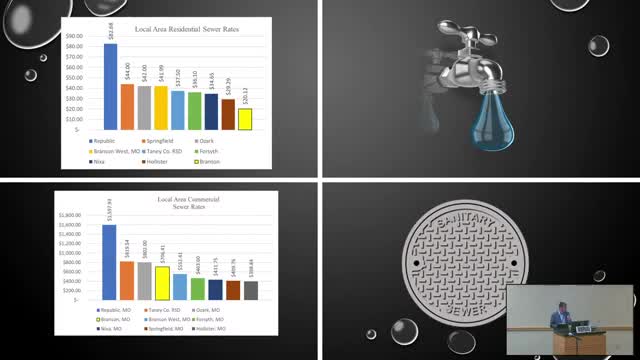Water and sewer rates under scrutiny as commercial usage spikes
August 28, 2024 | Branson, Taney County, Missouri
This article was created by AI summarizing key points discussed. AI makes mistakes, so for full details and context, please refer to the video of the full meeting. Please report any errors so we can fix them. Report an error »

In a recent government meeting, officials discussed the financial dynamics of local water and sewer rates, emphasizing the significant contribution of commercial users to revenue generation. According to reports presented, commercial entities account for 75% of the revenue, while residential users contribute only 25%. This disparity has led to a higher rate adjustment for commercial services compared to residential ones, a decision rooted in the need to maintain infrastructure and keep rates manageable for residents.
Officials highlighted that the tourism tax, which was supported by residents with the promise that 75% of the funds would be allocated to infrastructure, plays a crucial role in keeping water and sewer rates low. The commitment to fulfilling this promise remains a priority for the city, as officials aim to balance the needs of both commercial and residential users.
Additionally, discussions touched on the importance of cybersecurity in water and wastewater management, with recommendations for aldermen and residents to familiarize themselves with resources from the Cybersecurity and Infrastructure Agency. This initiative aims to enhance public understanding of the critical infrastructure that supports the community.
The meeting concluded with an acknowledgment of the city's unique position, serving a population of 12,000 while accommodating millions of visitors annually. Officials expressed gratitude for the diligent work being done to protect and maintain the water system, which is essential for both residents and tourists. The projected $55 million in expenses and capital improvements over the next six years underscores the ongoing commitment to infrastructure development, largely funded by the tourism tax.
Officials highlighted that the tourism tax, which was supported by residents with the promise that 75% of the funds would be allocated to infrastructure, plays a crucial role in keeping water and sewer rates low. The commitment to fulfilling this promise remains a priority for the city, as officials aim to balance the needs of both commercial and residential users.
Additionally, discussions touched on the importance of cybersecurity in water and wastewater management, with recommendations for aldermen and residents to familiarize themselves with resources from the Cybersecurity and Infrastructure Agency. This initiative aims to enhance public understanding of the critical infrastructure that supports the community.
The meeting concluded with an acknowledgment of the city's unique position, serving a population of 12,000 while accommodating millions of visitors annually. Officials expressed gratitude for the diligent work being done to protect and maintain the water system, which is essential for both residents and tourists. The projected $55 million in expenses and capital improvements over the next six years underscores the ongoing commitment to infrastructure development, largely funded by the tourism tax.
View full meeting
This article is based on a recent meeting—watch the full video and explore the complete transcript for deeper insights into the discussion.
View full meeting
